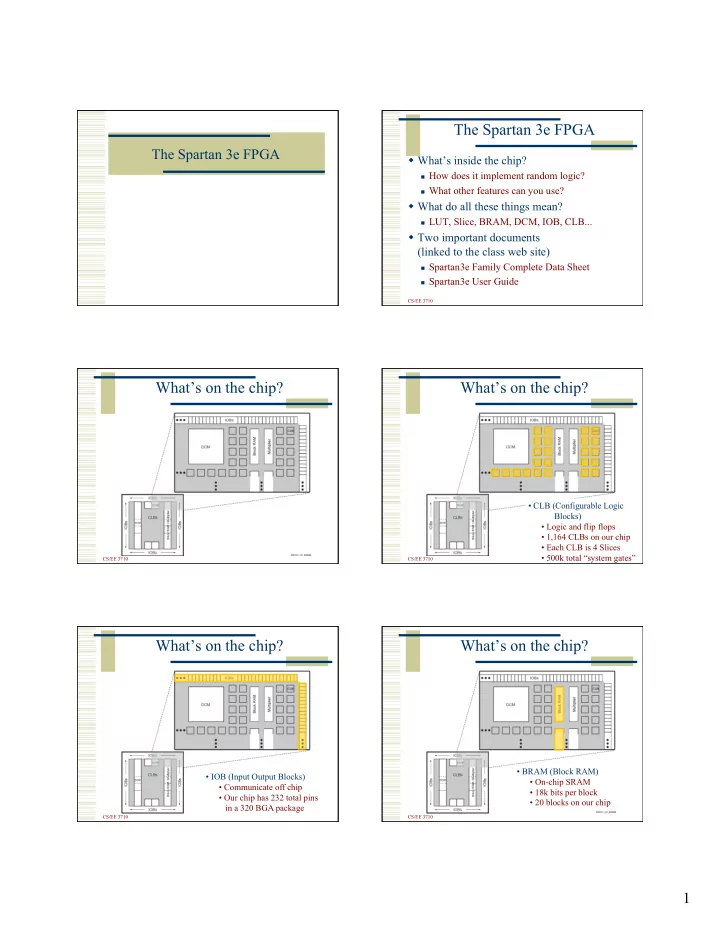

The Spartan 3e FPGA The Spartan 3e FPGA What’s inside the chip? How does it implement random logic? What other features can you use? What do all these things mean? LUT, Slice, BRAM, DCM, IOB, CLB... Two important documents (linked to the class web site) Spartan3e Family Complete Data Sheet Spartan3e User Guide CS/EE 3710 What’s on the chip? What’s on the chip? • CLB (Configurable Logic Blocks) • Logic and flip flops • 1,164 CLBs on our chip • Each CLB is 4 Slices • 500k total “system gates” CS/EE 3710 CS/EE 3710 What’s on the chip? What’s on the chip? • BRAM (Block RAM) • IOB (Input Output Blocks) • On-chip SRAM • Communicate off chip • 18k bits per block • Our chip has 232 total pins • 20 blocks on our chip in a 320 BGA package CS/EE 3710 CS/EE 3710 1
What’s on the chip? What’s on the chip? • DCM (Digital Clock Manager • Multiplier • Clock generation and • Custom 18x18 multiplier distribution • One per RAM block... • Four on our chip CS/EE 3710 CS/EE 3710 What’s on the chip? CLB: Configurable Logic Block 4 “Slices” per CLB The slices work together to make logic, flip flops, distributed RAM, or shift registers Connected to other CLBs through Switch Matrix • Programmable Interconnect • Connect everything together • Perhaps the most critical part of the chip! CS/EE 3710 CS/EE 3710 Left and Right Slices SRL16 = 16-bit shift register RAM16 = 16-bit RAM (16x1 bit memory) LUT4 = four-bit lookup table (16x1 bit memory) SLICEM = slice that can be memory or logic What’s SLICEL = slice that can only be logic Really in a Slice? CS/EE 3710 CS/EE 3710 2
LUT 4 – Basic Building Block LUT 4 – Basic Building Block CS/EE 3710 CS/EE 3710 Slice Muxes extend LUT4 Once CLB – up to LUT7 CS/EE 3710 CS/EE 3710 Top Half of a SliceM (left) Top Half of a SliceM (left) CS/EE 3710 CS/EE 3710 3
Logic-only (combinational) Logic + register (sequential) CS/EE 3710 CS/EE 3710 Just register Fast Carry Path (arithmetic) CS/EE 3710 CS/EE 3710 Fast Carry Path (arithmetic) Fast Carry Path (arithmetic) CS/EE 3710 CS/EE 3710 4
Mapping to CLBs Mapping to CLBs Each LUT can go through a flip flop How about these? So, these circuits map to the same number of Slices CS/EE 3710 CS/EE 3710 Mapping to CLBs CLB Summary How about these? Each CLB = 4 slices Each slice contains 2 LUT-4 LUT can be random logic, or 16x1bit RAM or SR 2 flip flop MUXs Carry logic ISE reports how many slices you use among lots of other things... CS/EE 3710 CS/EE 3710 IO Blocks IO Blocks Connections to the Connections to the outside world NOTE! No 5v! outside world Each pin can be Each pin can be configured a large number of ways configured a large Different signaling number of ways voltages and drive Different signaling currents voltages and drive currents CS/EE 3710 CS/EE 3710 5
Interconnect Inside an IOB Actually the most important part of the FPGA! Consumes the most area on the die Consumes the most power on the die In most cases, wires limit the performance But, hardly mentioned in the datasheet People are more impressed with logic CS/EE 3710 CS/EE 3710 Interconnect Interconnect RAM-programmable switches 2,270,208 bits of configuration RAM! Compare to 368,640 total bits of Block RAM or 74,752 total bits of Distributed RAM (LUTs) Hierarchical organization Many fast, short wires with small drive Fewer longer wires with high drive LOTS of work goes into picking just the right mix! CS/EE 3710 CS/EE 3710 Interconnect Clock Routing Routed on a separate dedicated network Another reason to avoid gated clocks Four types of wires Recursive “Fish bone” network that minimizes clock skew Clocks come from off-chip, or from a DCM CS/EE 3710 CS/EE 3710 6
Spartan XC3E500S Block RAM We’ve seen details of these already… CS/EE 3710 CS/EE 3710 Behavioral Template Structural Template Dual-port 1 R/W 1 R CS/EE 3710 CS/EE 3710 Structural Template Distributed RAM CS/EE 3710 CS/EE 3710 7
Distributed RAM Distributed RAM Dual-Port Distributed RAM CS/EE 3710 CS/EE 3710 Distributed RAM Digital Clock Manager (DCM) Dual-Port Distributed RAM CS/EE 3710 CS/EE 3710 Digital Clock Manager (DCM) Digital Clock Manager (DCM) CS/EE 3710 CS/EE 3710 8
Clock Skew Clock Skew CS/EE 3710 CS/EE 3710 Multipliers Multipliers CS/EE 3710 CS/EE 3710 Synthesis Output (mips example) Synthesis Output (mips example) CS/EE 3710 CS/EE 3710 9
Synthesis Output (mips example) Synthesis Output (mips example) CS/EE 3710 CS/EE 3710 Synthesis Output (mips example) Implement Output (mips example) CS/EE 3710 CS/EE 3710 Implement Output (mips example) Implement Output (mips example) CS/EE 3710 CS/EE 3710 10
Implement Output (mips example) Implement Output (mips example) CS/EE 3710 CS/EE 3710 Implement Output (mips example) Implement Output (mips example) CS/EE 3710 CS/EE 3710 Conclusion ASIC vs. FPGA FPGAs are complex beasts! Made to be very general and flexible ASIC vs. FPGA? Rule of thumb, FPGA about 5 times slower clock than ASIC FPGAs consume more power FPGAs are bigger for the same function ASICs are much more expensive to develop NRE – Non-Recurring Engineering CS/EE 3710 CS/EE 3710 11
Recommend
More recommend